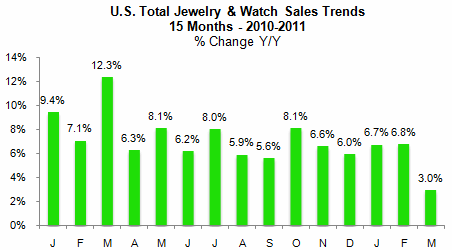IDEX Online Research: U.S. Jewelry Sales Slacken in March
May 16, 11
(IDEX Online News) - Jewelry and watch demand softened moderately in the U.S. market in March. New data indicates that total jewelry and watch sales rose by 3.0% over the same month a year ago, the smallest gain since late 2009, when the industry was just beginning to recover from the recession.
While the post-recession economy remains choppy, jewelry sales in prior months had been showing consistent solid gains. However, March sales appear to be an aberration from those trends.
Based on three months of 2011 sales data, the U.S. jewelry and watch sales could reach $65-66 billion for the full year ending December 2011, a gain of about 4% over 2010 sales levels. This gain would be in line with historic annual sales trends. However, it is important to note that a single month does not make a trend. Sales data will be revised over the next few months.
The table below summarizes key jewelry sales trends in the U.S. market.
|
Here are the current jewelry and watch sales trends in the U.S. market, based on new data for March 2011.
· Total jewelry and watch sales showed a modest gain – +3.0% – in March 2011 (versus March 2010), based on preliminary numbers. Industry sales were an estimated $4.4 billion for the month of March 2011 up from an estimated $4.3 billion a year ago. In part, the modest gain for March was due to a difficult comparison last year: a gain of over 12%, which was the largest monthly gain in 2010.
· Total jewelry and watch sales were revised downward for the prior month – February 2011 – to a gain of 6.8% for the month (versus February 2010). Preliminary numbers had shown a much stronger gain of 8.7%. Despite this downward revision, Valentine’s sales were strong for U.S. jewelers.
· During March, specialty jewelers took significant market share from other merchants who sell jewelry, based on preliminary numbers. According to the Department of Commerce, specialty jewelers’ March sales rose by a robust 9.7%. This is inconsistent with sales data obtained from the IDEX Online panel of jewelers; their gains were much more modest. However, LGI Network sales of branded jewelry showed a gain of about 7% for the month of March 2011.
· Watch sales declined modestly in March. This reflects a long term trend of weak watch sales versus gains in jewelry sales. However, LGI Network data for watches showed a very different picture: watch sales were up nearly 11% in March, based on total dollar sales, and unit sales of watches advanced by nearly 2%.
· The jewelry and watch industry lost market share to other retail categories during March. This is atypical in a post-recession period. Historically, jewelry demand usually falls faster at the beginning of a recession, but recovers at a greater rate than retail sales in a post-recession era. However, we continue to note that it is likely that March sales data will be revised, perhaps substantially.
· The retail jewelry market remains bifurcated: low-priced and high-priced merchandise seems to be selling well, while goods priced in the middle - $500 to $1,000 – have experienced softer demand, though they are showing growth.
The graph below summarizes jewelry and watch sales in the U.S. market over the past fifteen months. Overall, over this period, jewelry sales gains have been relatively steady.

Source: US Dept of Commerce
Outlook Remains Solid
With the elimination of Osama bin Laden, American consumer sentiment has changed dramatically. The president’s approval rating has soared, and even Tea Party members are cheering him on. This burst of “feel-good” patriotism should help boost jewelry sales.
However, longer term challenges remain in place: choppy global economic activity, a series of natural disasters, saber-rattling in Arabic countries, and other unsettling events continue to plague consumers across the world. At some point, it would seem that shoppers might pull back on their discretionary luxury purchases, until the current storm blows over.
Over the next couple of years, we believe that jewelry sales gains will settle in at about 4% or so annually. The current annual “run rate” for jewelry and watch sales in the U.S. market indicates that total industry revenues could reach $65-66 billion or so in 2011, a 4% increase over 2010’s $63.2 billion.
The full analysis of U.S. jewelry and watch sales in February is available to IDEX Online Research subscribers and IDEX Online members here. Click here for more information on how to subscribe or become a member.